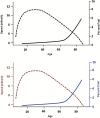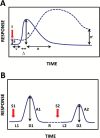Resilience in Aging Mice
- PMID: 27535963
- PMCID: PMC5865545
- DOI: 10.1093/gerona/glw086
Resilience in Aging Mice
Abstract
Recently discovered interventions that target fundamental aging mechanisms have been shown to increase life span in mice and other species, and in some cases, these same manipulations have been shown to enhance health span and alleviate multiple age-related diseases and conditions. Aging is generally associated with decreases in resilience, the capacity to respond to or recover from clinically relevant stresses such as surgery, infections, or vascular events. We hypothesize that the age-related increase in susceptibility to those diseases and conditions is driven by or associated with the decrease in resilience. Thus, a test for resilience at middle age or even earlier could represent a surrogate approach to test the hypothesis that an intervention delays the process of aging itself. For this, animal models to test resilience accurately and predictably are needed. In addition, interventions that increase resilience might lead to treatments aimed at enhancing recovery following acute illnesses, or preventing poor outcomes from medical interventions in older, prefrail subjects. At a meeting of basic researchers and clinicians engaged in research on mechanisms of aging and care of the elderly, the merits and drawbacks of investigating effects of interventions on resilience in mice were considered. Available and potential stressors for assessing physiological resilience as well as the notion of developing a limited battery of such stressors and how to rank them were discussed. Relevant ranking parameters included value in assessing general health (as opposed to focusing on a single physiological system), ease of use, cost, reproducibility, clinical relevance, and feasibility of being repeated in the same animal longitudinally. During the discussions it became clear that, while this is an important area, very little is known or established. Much more research is needed in the near future to develop appropriate tests of resilience in animal models within an aging context. The preliminary set of tests ranked by the participants is discussed here, recognizing that this is a first attempt.
Keywords: Aging; Health Span; Resilience.
Published by Oxford University Press on behalf of The Gerontological Society of America 2016. This work is written by (a) US Government employee(s) and is in the public domain in the US.
Figures


References
-
- D’Agostino RB, Sr, Vasan RS, Pencina MJ, et al. General cardiovascular risk profile for use in primary care: the Framingham Heart Study . Circulation . 2008. ; 117 : 743 – 753 . doi: 10.1161/CIRCULATIONAHA.107.699579 - PubMed
-
- Pride H, Yu Z, Sunchu B, Mochnick J, Coles A, Zhang Y, et al. . Long-lived species have improved proteostasis compared to phylogenetically-related shorter-lived species . Biochem Biophys Res Commun . 2015. ; 457 : 669 – 675 . doi: 10.1016/j.bbrc.2015.01.046 - PubMed
MeSH terms
Grants and funding
LinkOut - more resources
Full Text Sources
Other Literature Sources
Medical

